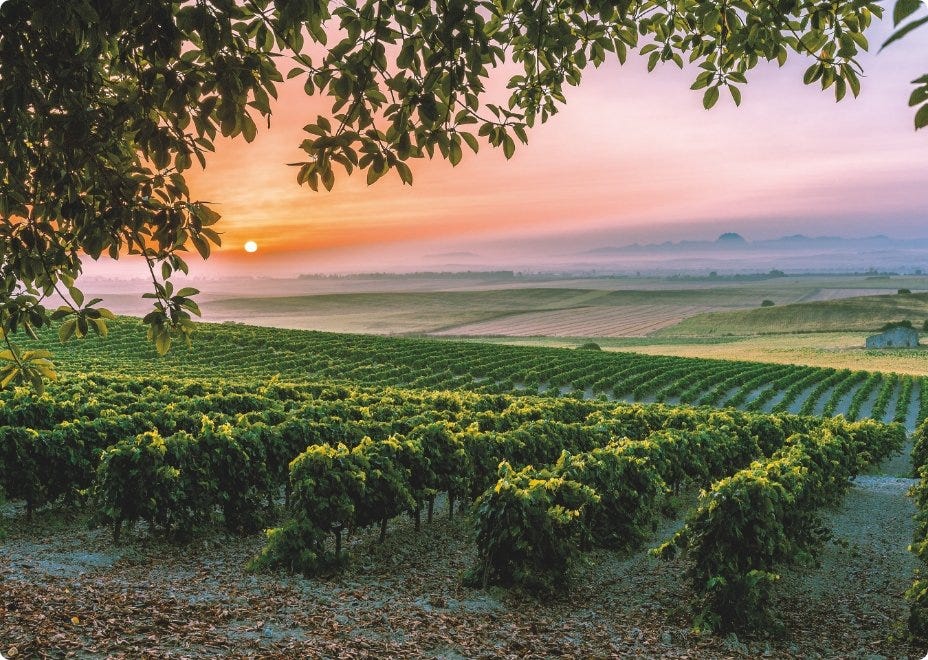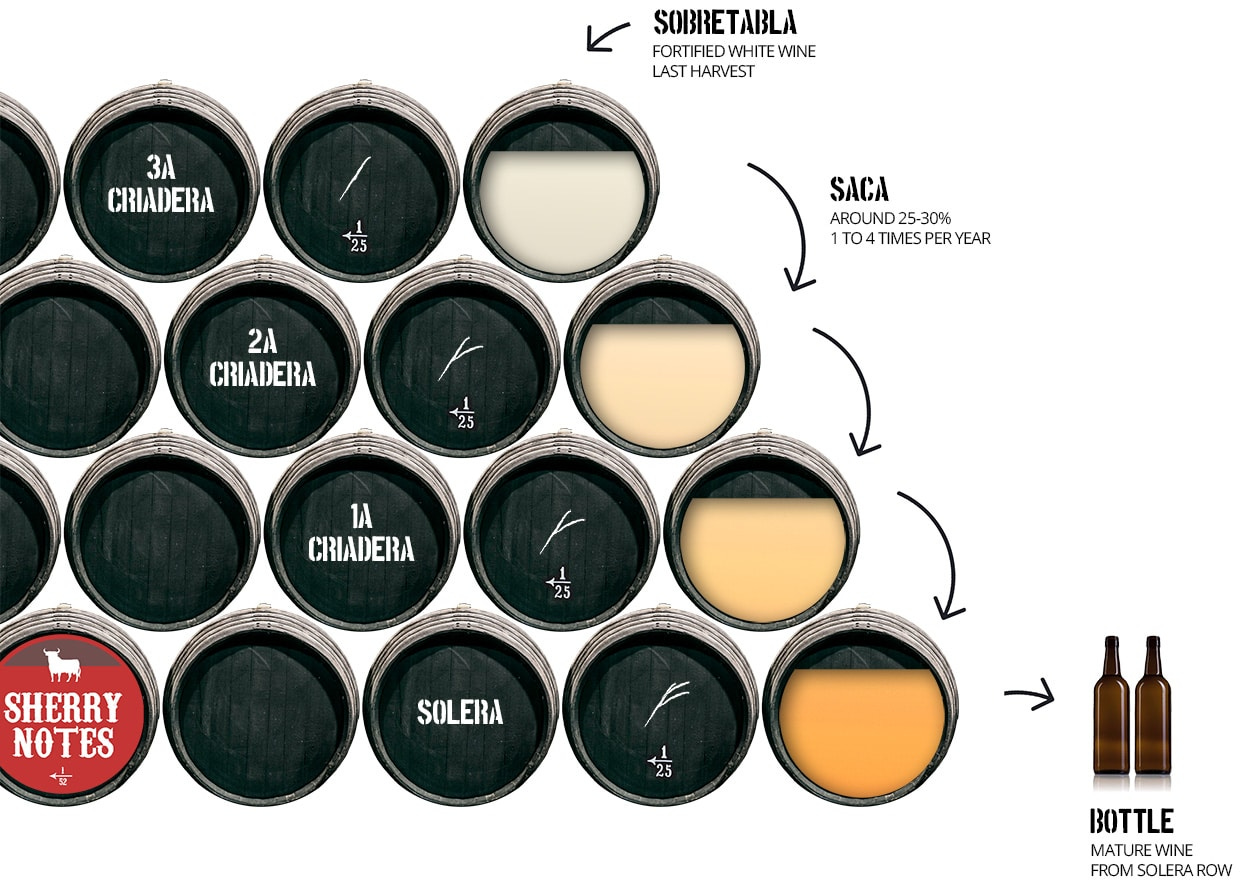Deep Dive: Sherry
The once and future king (of low-proof ingredients).
There are, of course, devoted followers of all random ingredients that I write about in this newsletter. However, they’re usually few and far between, and I often find myself as one of the chief evangelists of most of the strange bottles I write about.
Not so with sherry. There are thriving communities of devotees and dozens of books written about sherry, and you could consume all of that content and still have more to learn. I…have not consumed all of that content. I am a sherry novice. My goal today is to provide a very baseline understanding and hopefully point you in the right direction to learn more and get to making tasty low-proof high-punch drinks.
The Place
Sherry is wine, first and foremost. Like Port and Madeira, it’s fortified but the wine matters and it can’t just come from anywhere. To be sherry, it must be made in Andalucía. The closer it is to the city of Jerez, the better - traveling just a bit northwest through Spain as you cross the Strait of Gibraltar. There are other wines and winemaking regions here as well, but really it’s sherry country. And, as you might expect, it’s beautiful.
Jerez, where sherry is grown, is likely Spanification of the Arabic name for the city: Sherīsh. The name for the wine stuck a bit more directly than the city once the Spaniards regained political and cultural control of the region in the late 13th century. The vineyards had survived Muslim rule on the grounds that they could produce raisins to feed the army, so the grapes had been growing there and the winemaking process established when transatlantic trade picked up, and the same boats that would eventually take on Madeira almost certainly had sherry in the hold as well. Both Columbus and Magellan traveled with it, the latter famously having spent more on the booze than weapons.
Jerez is warm for wine country: summer highs are often in the 90s and the lows don’t go below the 60s, so it’s almost always ~10 degrees warmer than wine country in France. They do get daily moisture from the coast, though, which helps keep the crops in balance. The climate combined with the soil and landscape came together to influence a winemaking style you won’t find anywhere else.
The Grapes and The Process
Today, there are 3 white grapes used to make all varieties of sherry. There likely used to be hundreds, but a plague of Phylloxera in the late 1800s decimated the crops and it didn’t make sense, and maybe just wasn’t possible, to directly replace everything that was lost. Now, sherry comes from Muscat (moscato) that produces sweeter wines, Pedro Ximenez that also produces sweeter wines (and sounds awesome), and Palomino - a neutral table wine grape that produces the vast majority of sherry. All of these grapes are found elsewhere too, but Palomino is most-used and most-famous for its production of sherry.
The actual winemaking process differs somewhat among the varieties that I’ll detail below, but for the most part all sherry starts out the same way. The grapes are pressed multiple times, and the juice that’s extracted after each pressing will be used to create a different variety of sherry. The “first press” is generally considered to be the best.
Regardless of which press the juice is from, it ferments in neutral tanks for ~3 months that results in a dry white wine that’s likely not very good but also not too different than any dry white. Some very high-end sherries are still fermented in oak at this stage, but that’s rare and pricy. This is the stage at which the wine’s potential is judged by the producer, which determines how much spirit is added. That’s the point at which the wine definitely fits into one of the many varieties of sherry.
The spirit addition is interesting - usually with fortified wines, the producers say they “add brandy” and move on from the topic as quickly as possible. With sherry, they’re a bit more up-front. They do use a grape brandy (which is just distilled wine) and they mix it 50/50 with a matured sherry first. That’s the spirit blend that’s then added to the non-fortified juice to bring it up to the desired ABV. The goal here is to introduce less of a shock in the spirit addition, though I don’t understand the science well enough to comment on if that’s actually necessary.
All sherry is first aged in North American oak barrels, like Bourbon (though that has to be explicitly American). The barrels are only filled about 80% of the way and not fully sealed so that there’s space at the top and fresh air for flor to develop, which is a yeast film that grows on top of the wine. This is usually something that winemakers want to avoid at all costs, but in sherry it’s absolutely critical to have happen. It lends an extra yeasty, bready taste to sherry that’s almost always the dominant flavor on the palate.
If that’s not enough for unique aging, the sherry then heads to the solera system. This is very traditional and complicated, and I won’t try to give all of the details here. I’ll leave that to the devotees at Sherry Notes, who also developed the graphic below:
The idea here is that the wine is moved down the system in small amounts several times a year, and the blend of the oldest wines at the bottom of the system is what actually makes it into the bottle. It’s a fractional blending process that should, theoretically, naturally lead to consistency across bottlings. Each variety has it’s own section: they’re determined before this process, and any single solera section yields a single variety of sherry.
The Varieties
We’re a thousand words into this and we haven’t even touched the varieties yet. I won’t spend too much time here, because the varieties are primarily a function of how much spirit blend was added (so how boozy it is) and how much sugar is added later. Varieties exist in a classification of Dry, Sweet, and Sweetened, with each classification holding several varieties. There can also be sub-varieties below that, but that’s way too detailed for this post.
Dry
This is the standard - if you see a sherry on a shelf, it’s probably dry. These are lower-alcohol (~17%) and should generally be relatively sour and bitter compared to a regular dry white. That’s why they work so well in cocktails, and the varieties differ enough here to quickly dive into each of the major ones.
Fino
It literally means “light",” and that’s what you’ll find here. The driest sherry you’ll find with the most contact with the flor, it’s exceptionally bready for being so light-bodied and you should pick up some brine, too. These are always made from the first press of juice. Subs great as a vodka or gin.
Amontillado
Not just a plot device for Poe, Amontillado is Fino that has the flor intentionally broken up to allow for light oxidization. This is nowhere near the oxygen level that Madeira gets, but there’s still a little bit of that burn on the palate. The color is darker and the flavor is deeper, especially where you’ll find some nuttiness, and I think it subs in well as a rum.
Oloroso
The booziest dry sherry, Oloroso is Amontillado that spent even more time in the open air. It’s a bit sweeter and much nuttier than the other dry sherries, and it will sub in well for a whiskey or brandy in a cocktail.
Sweet
These are dessert wines, generally, and they used to be quite popular. That’s probably why, if you think of sherry at all, you probably think of it like Port. These can be sweet enough that you can use it a syrup as an ingredient. The names you’ll see here are Pedro Ximinez and Moscatel with the former being the sweetest available.
Sweetened
Unlike “sweet” sherries, which are sweet naturally based on the residual sugar from the grapes, these are truly sweetened after aging by adding sugar. Weirdly, that generally makes them less sweet overall. You’ll often see these called out as Cream sherry or “medium” sherry, and they’re really a different beast entirely.
Historical Popularity
Following the boom in production when Jerez again became Spanish in the late 13th century, sherry developed a reputation for being the finest wine available across Europe by the late 16th century. That’s quite the 300-year glow-up, from raisins to royalty. That’s partially because, when the English defeated the Spanish Armada, sherry was chief among the spoils.
Sherry remained popular across the world for a long time after that, appearing frequently in popular fiction from Poe to Fleming to Frasier. It seems to have really caught on with the Greatest Generation in the US for some reason; I frequently hear “my grandparents used to drink sherry” as I espouse its virtues to house guests. And it seems to be making a major comeback today, though it’s always been popular in its home country.
Cocktail Overview
A big reason for the sherry revival is how well it works in cocktails, especially as a replacement for the base spirit. That makes a very interesting cocktail that will be significantly lower-proof than the “standard” without tasting any kind of watered down. I do think that the Iberian Drought is a great example.
Simpler than that, and still delicious, are the increasingly-popular Bamboo and Adonis, a sherry-swapped Martini and Manhattan respectively. Sherry tends to play very nicely with any other aromatized/fortified wine, and both of those drinks are both super-simple and delicious.
Summary
Sherry is a massive, historic category of wine that you could spend your life learning about. It’s unique winemaking process creates dry, stiff fortified wines that can often sub for a base spirit in a cocktail to great effect, and they’re fun to drink on their own too.



